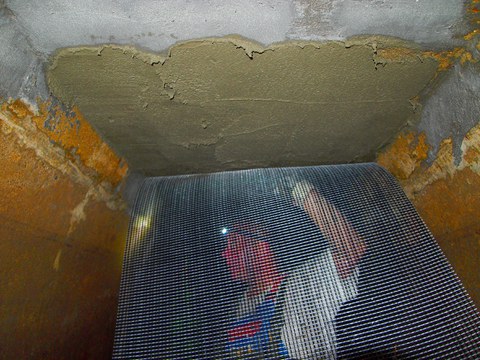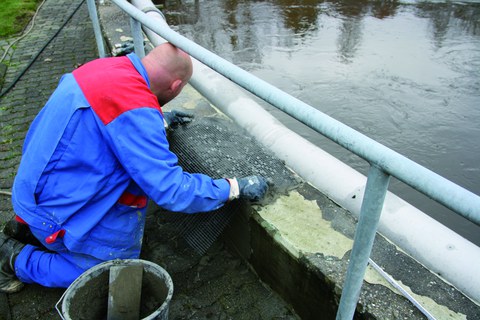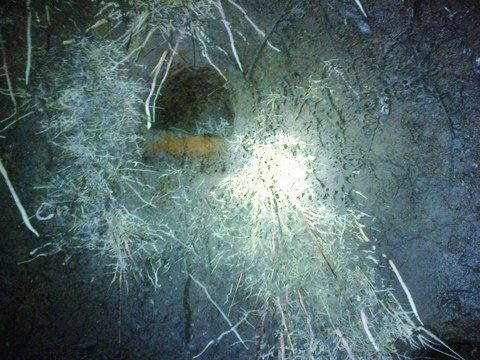TRC for maintenance, repair and rehabilitation of sewer systems
Table of contents
Project data
|
Titel | Title |
Report in the yearbook 2015
TRC for repair of wastewater structures

Textile reinforced concrete work at the crown in the sewer
Surveys of the German association for water, wastewater and waste show, that a large part of the canalisation in Germany has already reached an age, where the susceptibility to damages increases significant. Action is required here, so that the widespread disposal of wastewater can be guaranteed. Textile reinforced concrete (TRC) seems to be a wise addition to the current, mostly expensive, renovation methods. Usually, only local defects need to be repaired, which is easy to do with TRC. TRC seems to be predestined to an application in waste water area because of its material properties, which result in thin layered structures and fine crack patterns. But investigations into this area are still rare.
An appropriate concrete and carbon textile for sewer construction were chosen for the extensive investigations that were conducted involving the behaviour of the composite material under chemical attack in a research and development project. The results show that the environmental conditions have a significant influence on the load-bearing capacity and load-bearing behaviour. While storing specimen in sodium sulphate solution, the load-bearing capacity was reduced by 22 % compared to that of a specimen stored under normal conditions (20 °C, 65 % relative humidity). The reduction depends on both the storage time in the faulty solution and the type of concrete used. The bond behaviour between the roving and the concrete is also changing, and it has to be taken into consideration at the construction, but the basic material behaviour of the textile fabric remained unchanged.
With these new insights, the crown of a real sewer could be repaired. Extensive deterioration of the concrete and some steel corrosion were the reasons for taking action. After proper surface preparation, the TRC layer could be applied. Afterwards, the activities were evaluated together with the industrial partner. To promote TRC quality standards, a manual was developed together. Also, a procedure for structural monitoring of the specimen was developed, which is still on-going after the end of the research project.
Report in the yearbook 2014
Rehabilitation of wastewater sewer

Testing of a rehabilitation opportunity with textile reinforced concrete at a settling basin
A survey of the German Association for Water, Wastewater and Waste (DWA) in 2009 showed that 32 % of the sewer system in Germany has an age of over 50 years. With a rising structure age, the liability to damages is rising too. The existing damage must be repaired to guarantee the function of the sewer system. Given the existing rehabilitation options, not every case of damage can be repaired appropriately and efficiently. The use of textile reinforced concrete (TRC) can be a reasonable complement of the common rehabilitation methods. The advantages of TRC over conventional methods, for example, the good adaptability to curved shapes, the fine crack-pattern at high loading and the high concrete quality, should be used advantageously at sewage rehabilitation sites. But, until now, there is no record of use nor behaviour data of TRC in sewage constructions.
To study the in-situ behaviour of TRC in sewage constructions, a repair of the sewer peak using TRC in a sewage section of the urban drainage of Dresden was completed. The work became necessary, because at the sewer peak location the concrete was partially damaged and the reinforcing steel was corroded. Before the rehabilitation work could start, the sewer was cleaned, the corrosion products were removed, the concrete was re-alkalized and re-modelled and – if necessary – it was roughed-up by high pressure water. Afterwards, TRC was applied in layers. The major difficulty was to transport the material in a workable state from the shaft entrance to the working place and to handle it carefully in close quarters. The work was finished within 14 days. In another pilot project, TRC was used for rehabilitation of a tank head of a sewage plant. The test field application will be subjected to an expert opinion in spring which will provide an evaluation to determine if textile reinforced concrete is a suitable repair option.
Furthermore, specimens were tested under sulphate-attack conditions, similar to those found in the sewer. In tensile tests, the loading capacities of textile reinforced specimens were reduced by about 22 %, if the samples were stored in a sulphur bath, compared with specimen under normal conditions. For the intended application, a decrease in strength of this magnitude should be completely uncritical.
Report in the yearbook 2013
TRC in the Field of Sewerage

Growing roots in a sewer in the area of a branch.
Germany has an extended sewer system of more than 541,000 km. About 55,000 km of the sewers, which are mostly made of concrete, can be entered. In addition, there are approximately 13.5 million manholes. However, most of the structures are already quite old and frequently in need of repair. The current investment backlog in the national sewerage system has been estimated at approximately 55 billion euro.
In particular the sewer pipes, but also the manholes are constantly exposed to enormous pressure. Apart from the lateral earth pressure and the pressure of traffic, the structures are especially affected by the chemical and mechanical influences going along with the transport of wastewater. Due to this strain, which is extraordinarily high in comparison to other structures, damage occurs quite frequently. It is most often caused by cracks, root invasion and surface damage caused by corrosion. Amongst other things, these damages result in the infiltration of wastewater from the sewer system into the soil thus polluting the groundwater. On the other hand, the amount of permeating groundwater and leachate increases the amount of water that has to be treated. This in turn results in an increase in costs.
Based on the increased demands, the capability of the repair systems currently available is often not sufficient with regard to technological properties, efficiency, sustainability and wear. As a result, the idea to test the applicability of textile reinforced concrete, which was originally developed for the strengthening of load-bearing structures and the repair of concrete in building construction, was devised. So far, the experience with this composite at the Institute of Concrete Structures suggests that strengthening and repair work is equally possible when building sewers, in hydraulic engineering and in civil engineering. Due to the special influences on materials in sewer systems compared to conventional building construction, a number of questions still remain to be answered. These mainly concern the building material in itself e.g. with regard to processing, chemical resistance or abrasion, but also the bond between strengthening layer and the existing structure as well as the durability of the entire structure after the repair work has been carried out. In the current project, these questions shall be scientifically researched and applied in a realistic renovation procedure.
